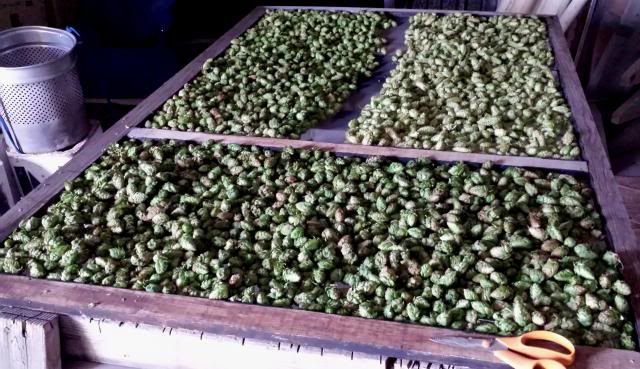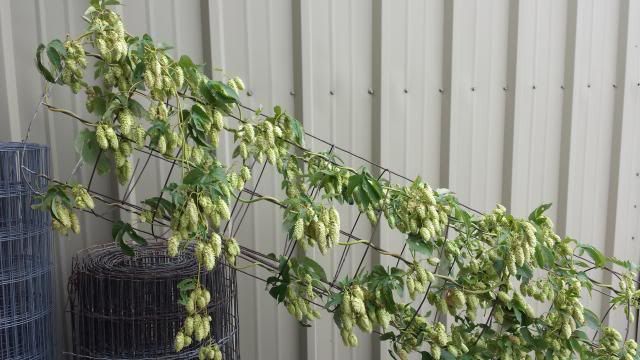Tom, thanks for the term. I had never known the actual name for it. On a related note, i did do a few mins searching the web and it does appear as though hops do require vernalization. I know what you mean in wondering why it doesn’t occur sooner; however, i do recall that people that bonzai do have to allow plants to vernalize every so many years, otherwise they die.
Probably isn’t practical but someone did it. They actually just dug up the crowns and put them in the fridge at 3C. The ones that were removed and planted after 5 weeks didn’t show any growth but after 6 weeks, they grew. This comes from this book: http://www.amazon.com/Hops-R-A-Neve/dp/0412303302. Got it back in the early 90’s from Brewers Publications for something like $70.
There seems to be a combination of factors pertaining to shortening day length combined with the gradual cooling of temperatures that triggers the plant to cease vegetative growth (top growth) and begin to send any starches that were contained within the stems down into the below ground portions of the plant for storage. I’m sure that these conditions aren’t met down in Fla. and would guess that possibly some of the starches made their way down into the crown/storage roots to allow the plants to gradually die off over a year or two. Even though the plants didn’t go through a true vernalization there may have been enough starch in reserve to allow them to grow a few more years.
Harvesting here:
Drying some cascade, columbus, and some mystery hop that appeared about 150 feet away from any other plant.

Here is the mystery hop…super long pendulous pale yellow cones on long stems, very incised and deeply lobed leaves…it is very distinctive and looks this way each year. Have yet to brew with it. Smells wicked strong.
B-Hoppy or anyone else; have any ideas about other varieties that may display these traits?



\Cheers to sticky smelly fingers! :cheers:
Neomexicanus?
hmmm, interesting. It is true that the nearest hop plant…maybe 100 feet is in fact a neomexicanus that I pillaged off the mountain. I may have to compare those two again. Thanks.
Why can’t this book be found for less than $200? Does it grow hops for you?
I’m a first year hopper. I planted two plants - centennial and cascade. They seemed slow to develop. I do have a handful cones that are almost ready (judging by sound and feel). I have maybe 30-50 somewhat developed cones on both plants but especially on the cascade I must have over 100 new flowers just starting. I’m in the Chicago area. Is this normal?
A couple other questions:
-
With the cones in many states of development how do you harvest without needing to do so too often?
-
drying - I’ve seen many methods listed. I do have a dehydrator that I can set below 120 F that I may or may not use but how do you know when you are done?
-
I almost exclusively have used pellet hops. When ready to use these whole hops I have read some use more by weight than pellets. Is this true or not?
Thanks,
Mike
-
On my first crop I picked the ones that were mature and left the young ones since there was quite a bit of difference in maturity. For the second picking, I let the more mature ones hang until they just start to get a little yellow on the edges then picked everything. I could’ve maybe picked only the more mature ones but I had a lot of hops already and was frankly tired of picking. Plus I wanted to pull down the bines and clean things up before fall.
-
Dehydrator is fine although for a larger crop you’ll need to make something bigger. There are quite a few plans for oasts (oast is a hop dryer) on the web.
-
They say you use 10% more whole hops to get the same bitterness, thats a fairly modest change and not sure you’d even notice.
Pinnah, nice haul. I thought the mystery hop looked like Columbus due to the squarish shape and long length. But since you have Columbus to compare with, so it must not be those. They sure are pretty anyway, and I like the yellowish color. I’m guessing you’d get less grassiness from chlorophyll from those things.
So here is my harvest from last weekend.
The entire top row is a first year Columbus plant that went nuts
Lower level is L-R, Cascade, Centennial and Chinook.
I had gotten an earlier harvest off of the Centennial and Chinook. Looks like I will be getting another harvest off of all 4 of these in several weeks but not quite as large.
I have 5 more varieties, but not much yield from most of them
[quote=“560sdl”]So here is my harvest from last weekend.
The entire top row is a first year Columbus plant that went nuts
Lower level is L-R, Cascade, Centennial and Chinook.
I had gotten an earlier harvest off of the Centennial and Chinook. Looks like I will be getting another harvest off of all 4 of these in several weeks but not quite as large.
I have 5 more varieties, but not much yield from most of them[/quote]
That is awesome - I would love to see a picture of your plants.
Mike
[quote=“mbg”][quote=“560sdl”]So here is my harvest from last weekend.
The entire top row is a first year Columbus plant that went nuts
Lower level is L-R, Cascade, Centennial and Chinook.
I had gotten an earlier harvest off of the Centennial and Chinook. Looks like I will be getting another harvest off of all 4 of these in several weeks but not quite as large.
I have 5 more varieties, but not much yield from most of them[/quote]
That is awesome - I would love to see a picture of your plants.
Mike[/quote]
I will post something early next week. However, I actually cut the tops off if there was no new growth or flowers, knowing that there was no potential for more production up high. They are still pretty big and full though
560 thats my kind of oast. Paper boxes and window screens.
Just bagged up my harvest from my 3 first year cascades. Ended up with 10 1/2 ounces dry.
[quote=“560sdl”]So here is my harvest from last weekend.
The entire top row is a first year Columbus plant that went nuts
Lower level is L-R, Cascade, Centennial and Chinook.
I had gotten an earlier harvest off of the Centennial and Chinook. Looks like I will be getting another harvest off of all 4 of these in several weeks but not quite as large.
I have 5 more varieties, but not much yield from most of them[/quote]
Pretty Sweet.
I have harvested the four varieties in the last week or so at different times. It looks like I have abou the same amount between all four except the Chinooks. They were beast and filled two whole screens!
How long generally will it take to dry a single layer of hops on a screen? I picked a “screen full” Wednesday night, and they’ve been sitting in the garage since then. Should tonight (48 hours) be sufficient?
If you have air moving across them with a box fan, it shouldn’t take more than a few days. I live in upstate New York and My hops dried in two days with a box fan blowing on them from about 2 yards away. When they are paper light and fall apart if you handle them then they are dry enough to store.
Mine dry fine in 4-5 days without fans.
Just throwing out an update on my 2013 hop experience. I got 3lb dried of a field blend of Columbus, Centennial and something else that I forget now. I used darn near a pound in my first homegrown IPA. Used them for bittering, flavor, aroma, and dry hopping. Beer is now done and drinking, turned out very well. Plenty of bitterness, the combination of pine and grapefruit in the flavor and aroma, just a little hint of grassiness that I attribute to leaving the beer on the dry hops a bit too long. Overall a big success though, which means the other 2lb are going to get used this winter.
Well, hop growing season is officially over as I harvested that last bit of hops and cut down my bines. Kind of get teary eyed looking at that high trellis and nothing growing towards it.
Very interesting thread!!! I read the first 6 pages and see where there are some folks in warmer climates growing hops. Traditionally hops have always been grown in cooler climates. I’m from upstate NY and that was the hop capitol of America up until prohibition. I live just outside of Atlanta, but own property in far north Georgia which is cooler and at a higher elevation. Just wondering how the hops turned out from folks living in warmer (non-traditional) growing areas?